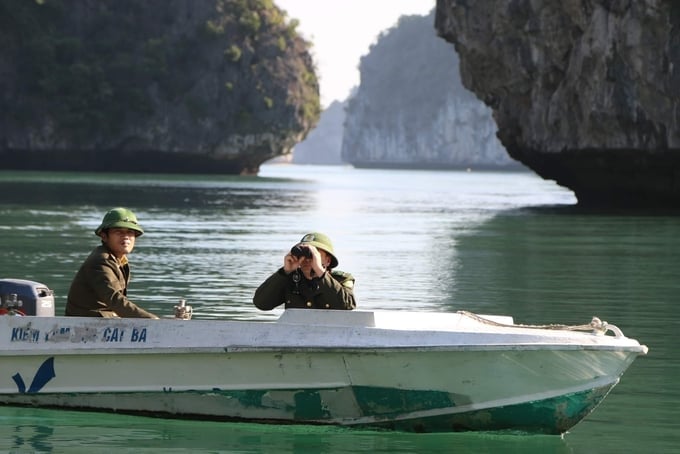June 19, 2025 | 01:13 GMT +7
June 19, 2025 | 01:13 GMT +7
Hotline: 0913.378.918
June 19, 2025 | 01:13 GMT +7
Hotline: 0913.378.918

The mangrove ecosystem in Xuan Dam Commune, Cat Hai District. Photo: Dinh Muoi.
According to the Hai Phong City's Department of Agriculture and Rural Development, a team of experts from the Korean Forest Service (KFS) recently visited Hai Phong City to conduct research and assess potential projects related to the restoration and sustainable management of mangrove forests.
The project "Restoration and Sustainable Management of Mangrove Forests in the Red River Delta," funded by KFS through a non-refundable aid program, has been implemented in the provinces of Nam Dinh and Ninh Binh from 2021 to 2024. This initiative has achieved its objectives and met the goals set by both governments. Consequently, KFS has expressed interest in exploring new project ideas in Northern and Central coastal provinces, including Hai Phong City.
In response to this proposal, Hai Phong City's Department of Agriculture and Rural Development accompanied the Korean experts to potential project sites in Cat Hai District during their visit to the city. Additionally, Hai Phong has requested KFS's support in implementing key measures for mangrove forest restoration and development.
For equipment, the Department has requested pickup trucks for forest patrol, protection, and fire prevention activities; patrol boats for the same purposes; as well as computers and printers.
For larger projects, the Department proposed the construction of wave-dissipating soft barriers and sedimentation platforms to restore and protect mangrove forests in the Phu Long tidal flats area. Other requests include the establishment of a temporary nursery for seedling production, five hectares of new mangrove forest, 40 hectares of supplementary mangrove forest area, and the installation of three forest protection observation towers. Additionally, the Department seeks support in developing livelihood improvement models for the local communities involved in sustainable forest management, such as beekeeping, mangrove ecotourism, and integrated forestry and aquaculture models.

Hai Phong has also requested KFS to support the provision of patrol boats for forest protection if the project is implemented. Photo: Dinh Muoi.
Hai Phong City is located in the lower reaches of the Thai Binh River system, with five major river mouths flowing into the sea: Thai Binh, Van Uc, Lach Tray, Cam, and Nam Trieu. The city currently houses over 151,000 hectares of natural forest area.
Hai Phong encompasses more than 24,000 hectares of coastal mudflats, including approximately 12,400 hectares of high-tide flats, 5,500 hectares of mid-tide flats, and 6,100 hectares of coastal sandbanks. The mangrove species in Hai Phong's coastal region are primarily located in seven coastal districts: Thuy Nguyen, Kien Thuy, Tien Lang, Cat Hai, Do Son, Duong Kinh, and Hai An. Over the years, Hai Phong City has received recognition for its significant tidal flats and mangrove forest potential.
Despite this potential, the mangrove forests in Hai Phong are currently at risk of both declining in area and in quality, failing to fully fulfill their vital role in environmental and social protection.
Moreover, the expansion of coastal aquaculture and the uncontrolled exploitation of natural aquatic resources within the mangrove forests are affecting ecological balance and depleting natural coastal fish stocks. Consequently, the project, if implemented with the necessary support, can potentially restore a considerable area of mangrove forests, thereby contributing to national security and enhancing coastal defense capabilities.
In 1989, Hai Phong's coastal region boasted approximately 3,270 hectares of mangrove forest. By 2007, this figure had decreased to 1,943 hectares with an ongoing steady decline. The reduction in mangrove forest area was caused by deforestation for rice production, aquaculture, resettlement, urbanization, and the development of economic zones. The most significant losses have occurred in Dinh Vu, Cat Hai, and Thuy Nguyen.
Tien Phong Newspaper recently planted 1.12 hectare of new mangrove forests in the K15 Pier, Do Son District, in a series of environmental protection activities titled 'The Green Dream.'
Accordingly, Tien Phong Newspaper, in collaboration with Hai Phong City's Department of Agriculture and Rural Development, launched a response to protect mangrove forests in K15 Pier, Do Son District, Hai Phong City on the morning of August 12.
At the event, Tien Phong Newspaper presented 2,600 trees, including 1,300 mangrove trees and 1,300 trang trees, to Hai Phong City's Department of Agriculture and Rural Development. These two native tree species boast strong growth and resistance to local soil and climate conditions.
Translated by Nguyen Hai Long
![Turning wind and rain into action: [9] Digitizing hydrometeorological data in response to climate change](https://t.ex-cdn.com/nongnghiepmoitruong.vn/608w/files/news/2025/06/17/z6704423696987_15fd32ffc26d590d204d520c9dac6786-nongnghiep-165943.jpg)
(VAN) Farmers have begun accessing hydrometeorological applications to adjust their cropping schedules, aiming to ensure productivity and adapt to climate change.
![Turning wind and rain into action: [8] Real-time salinity detection and early warning technology](https://t.ex-cdn.com/nongnghiepmoitruong.vn/608w/files/news/2025/06/17/z6704423696987_15fd32ffc26d590d204d520c9dac6786-nongnghiep-151127.jpg)
(VAN) Thanks to the integration of modern hydrological-hydraulic models, remote sensing technologies, and artificial intelligence, the accuracy of hydrological forecasting has significantly improved.
![Turning wind and rain into action: [7] Early disaster warnings help marine farmers minimize losses](https://t.ex-cdn.com/nongnghiepmoitruong.vn/608w/files/news/2025/06/17/z6704423696987_15fd32ffc26d590d204d520c9dac6786-nongnghiep-142942.jpg)
(VAN) In recent years, thanks to early disaster warnings and forecasting, marine farmers in Khanh Hoa province have been able to reduce risks and losses, thereby improving production efficiency.
![Turning wind and rain into action: [6] ‘Four on-the-spot’ disaster management software](https://t.ex-cdn.com/nongnghiepmoitruong.vn/608w/files/news/2025/06/17/e5a48259d6a262fc3bb3-nongnghiep-183800.jpg)
(VAN) By simply activating the scenario on the disaster management software, the relevant authorities immediately know how many households need to be evacuated, where to evacuate them to, and by what means of transportation…
![Turning wind and rain into action: [5] Hue applies modern technology in disaster forecasting](https://t.ex-cdn.com/nongnghiepmoitruong.vn/608w/files/news/2025/06/17/z6704423696987_15fd32ffc26d590d204d520c9dac6786-nongnghiep-093938.jpg)
(VAN) In Hue city, modern technology has recently been applied in meteorological and hydrological forecasting and warning, helping to reduce the damage caused by natural disasters.

(VAN) A cutting-edge farming technique being implemented on an experimental ranch in Arizona's Sonoran Desert has already saved a billion gallons of water over five years, according to Civil Eats.

(VAN) Poultry and pig production and the environment can be boosted through enhanced water technology, according to new research.